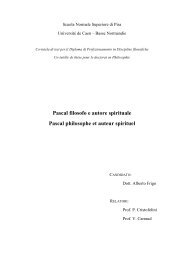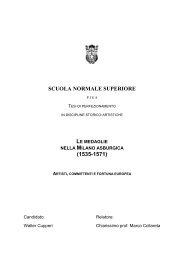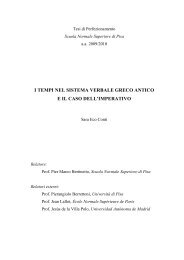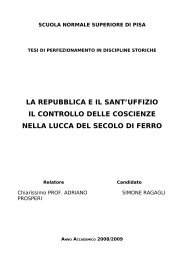CATULLUS 68 - Scuola Normale Superiore
CATULLUS 68 - Scuola Normale Superiore
CATULLUS 68 - Scuola Normale Superiore
Create successful ePaper yourself
Turn your PDF publications into a flip-book with our unique Google optimized e-Paper software.
The first table does, and it is surely of crucial importance for understanding Catullus <strong>68</strong>b. It shows among<br />
other things that lines 149-160 are an organic part of the poem, rather than accompanying it as a covering<br />
note. It is important, then, to take this concatenation for what it is: for nothing less, but also for nothing more.<br />
First of all, not all these sections correspond to neatly distinguishable units of text: sections B and D end in<br />
mid-sentence, as does probably section A. This means that the sections are more clearly articulated in the<br />
second half of the poem: the first half is simply characterized by a progression from theme to theme, while in<br />
the second half the same progression continues, but each theme also corresponds to one or more sentences.<br />
Nor are the pairs of corresponding sections of equal length, except for D and D’. This means that the<br />
structure of the poem is based merely on a progression of themes, and not of distinct units of text each of<br />
which is devoted to one particular theme. Why do the sections start to be articulated more clearly at the<br />
centre of the poem? The most radical explanation would be that Catullus composed its first half before<br />
deciding to go over the same themes once again in reverse order, so as to obtain the ‘Chinese box’ structure.<br />
But it is implausible that he should ever have intended the first half to stand alone, as it is not complete on its<br />
own: the poet can only have left off describing his rendez-vous with Lesbia with her still standing on the<br />
threshold (section B, lines 70-72) if he was planning to return to the subject and describe what happened<br />
afterwards (section B’, lines 131-134). At the very latest when he wrote line 73 Catullus must already have<br />
had the ‘Chinese box’ structure in mind – but his treatment of the structure changed as he was writing the<br />
poem. The second half of the text is articulated more clearly, it is more orderly, more closely argued, and<br />
perhaps even more rational than the first half. The reason may be simply that it is easier to start a project than<br />
to finish it off, to tuck away all the loose threads. Everyone who has gone on a long walk in the mountains<br />
will know that starting out is a relatively easy, almost impulsive activity, but it always takes an amount of<br />
rational planning to return.<br />
While the thematic progression within the poem is clear, not all pairs of sections treat exactly the same<br />
theme. There is no such problem with the mythological pairs, C and C’ as well as D and D’, as these<br />
basically tell two halves of the same story; but there are significant differences between A and A’, and<br />
between B and B’. In A the poet addresses the Muses to praise Allius, and he describes how Allius has<br />
helped him; in A’, which constitutes a sort of epilogue or envoi, the poet turns directly to Allius, wishes him<br />
well and greets him, his partner, the very house that Allius has arranged for him and its châtelaine, and he<br />
closes the poem with the poem with Lesbia. Not only are the contents of the two sections quite different, but<br />
at the end of the second one, and of the entire poem, there stands a reference to Lesbia (a very effective one,<br />
to be sure), which would be more at home in the sections B and B’. Likewise, the parallelism between B and<br />
B’ is limited: B consists of a short but memorable description of Lesbia’s arrival at the house procured for<br />
the lovers by Allius, while the first part of B’ (lines 131-136) completes this description, much as C’<br />
completes C and D’ completes D, but the second part consists of a long account of Catullus’ relationship<br />
with Lesbia (lines 137-148). In the biographic pairs of sections the thematic structure of the poem turns out<br />
66






